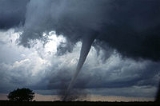
or, in rare cases, the base of a cumulus cloud
. They are often referred to as a twister or a cyclone, although the word cyclone
is used in meteorology in a wider sense, to name any closed low pressure
circulation. Tornadoes come in many shapes and sizes, but are typically in the form of a visible condensation funnel
, whose narrow end touches the earth and is often encircled by a cloud of debris
and dust
.
1680 The first confirmed tornado in America kills a servant at Cambridge, Massachusetts.
1840 The Great Natchez Tornado strikes Natchez, Mississippi killing 317 people. It is the second deadliest tornado in United States history.
1880 An F4 tornado strikes Marshfield, Missouri, killing 99 people and injuring 100.
1893 The small town of Pomeroy, Iowa, is nearly destroyed by a tornado that kills 71 people and injures 200.
1899 New Richmond Tornado: the eighth deadliest tornado in U.S. history kills 117 people and injures around 200.
1926 The deadliest November tornado outbreak in U.S. history strikes on Thanksgiving day. 27 twisters of great strength are reported in the Midwest, including the strongest November tornado, an estimated F4, that devastates Heber Springs, Arkansas. There are 51 deaths in Arkansas alone, 76 deaths and over 400 injuries in all.
1948 The first successful tornado forecast predicts that a tornado will strike Tinker Air Force Base, Oklahoma.
1953 In Warner Robins, Georgia, an F4 tornado kills 18 people.
1953 Flint-Worcester tornado outbreak sequence: A tornado hits Flint, Michigan, and kills 115. This is the last tornado to claim more than 100 lives.
1955 In the United States, a night time F5 tornado strikes the small city of Udall, Kansas, killing 80 and injuring 273. It is the deadliest tornado to ever occur in the state and the 23rd deadliest in the U.S.
Scenes of suffering and horror marked the storm and fire. Throughout the night relief workers and ambulances endeavored to make their way through the streets strewn with wreckage, fallen telegraph poles and wires and burning embers. The only light afforded was that of the burning area…![]()

